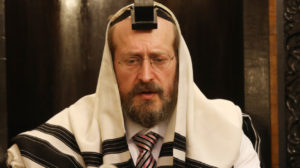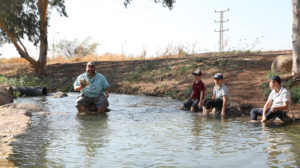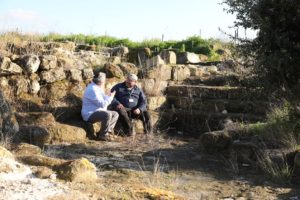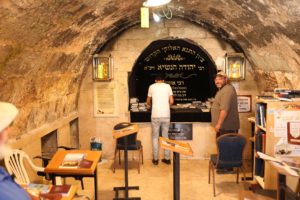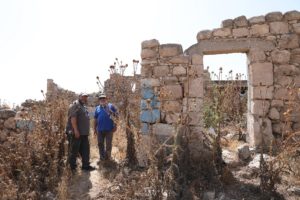Ayubowan any Jews here?

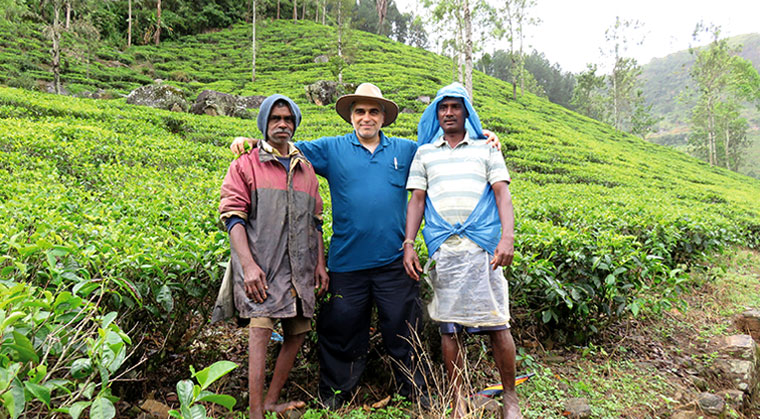
JUNGLE SECRETS The testimonies of a researcher and a local Holocaust survivor the path to the door of a Jewish monk and a mysterious discovery in the local cemetery seem to have unearthed Jewish roots in this remote tropical paradise (Photos: Yitzchak Carmeli Angelo Sagiv)
O ne thing I figured out on our excursion to Sri Lanka an island country off the coast of southeast India is that it’s a country of monkeys — no I mean real ones. These primates are everywhere slipping onto train tracks climbing onto rusting bridges leaping between the buildings in the capital city of Colombo or strolling leisurely through the shopping centers. When I settled on a city bench with some sandwiches a cheeky little monkey grabbed the bread out of my hand climbed up a nearby tree and looked back down at me as he sank his teeth into my lunch.
It seems like Colombo’s half a million residents — a collage of beggars and busy passersby — don’t even notice. And that’s not surprising given that the city is a stark mix of old and new backwoods village and modern metropolis all fused together. Most of the houses are old built during the Dutch and Portuguese colonial eras but the building boom that began after the country’s 35-year civil war ended in 2009 has contributed dozens of modern skyscrapers to the city.
My travel partner Angelo Sagiv and I came to Sri Lanka to see if we could find the remnants of a Jewish community that had apparently once been here. The country’s documented history spans 3 000 years and its geographic location and deep harbors made it a strategic juncture from the time of the ancient Silk Route. But for all its rich history the country — known as Ceylon until British colonial rule ended in 1972 — contains little documentation of any Jewish community.
Disappearing Act
The earliest evidence of Jewish life in Sri Lanka is in the memoirs of Binyamin of Tudela the famed traveler who lived more than 800 years ago. In his writings he describes a large Jewish community that he met here numbering about 3000 people. When the Portuguese occupied the island country in the 1500s it apparently became a haven for Jews from Portugal — but all traces of this community also disappeared with the Jews having assimilated into the local population. And even 300 years ago when the Dutch took over the colony from the Portuguese it’s safe to assume that many Jewish spice merchants settled here but again there is no remnant or record of their existence. Following the Dutch came the British colonialists and it is known that several members of the Rothschild family traded tea and spices during the British occupation but again no documentation exists of communal Jewish life.

After deciding to travel to Sri Lanka in an effort to track down the roots of the local Jewish community I came across a study by an Australian-based Sri Lankan researcher named Dr. Fiona Campbell who claims her own Jewish family roots go back at least 250 years.
One of her Jewish ancestors was Leopold Immanuel Jacob Van Dort a professor of Hebrew at the Christian Theological Seminary in Colombo who under Dutch rule was forced to convert to Christianity in 1758. Dr. Campbell isn’t the only Sri Lankan to claim Jewish lineage; in recent years it’s become somewhat of a trend. Many Sri Lankans with Portuguese roots claim their ancestors were Jews who fled here to escape the Inquisition of Spain and Portugal.
Search for the Shul
Among the testimonies Dr. Campbell gathered were recollections of a Jewish synagogue from sometime in the 20th century although there’s no remnant of the building today. The synagogue was apparently known as “the Rotunda” after its rounded architecture and was located near a site now known as Rotunda Gardens. Along with many other historic buildings around the country it didn’t survive three decades of civil war.
Those testimonies were corroborated by a local woman named Anne Ranasinghe — born Anneliese Katz in Essen Germany. In an essay Anne wrote for a Jewish publication and in an archived interview she explained that she survived the Holocaust after being sent to England as a child. She grew up in London where she met her Sri Lankan husband. They went back to his native land where he became a professor at Colombo Medical School and where she emerged as the country’s leading English-language poet. She never denied being Jewish but feeling culturally and spiritually isolated she decided to raise her children as Buddhists.
Anne who passed away this past December at age 91 said she did keep contact with the few Jews on the island that she knew about — mostly European women married to local men — and one friend made it clear that she wanted a Jewish burial and not a Sri Lankan Buddhist cremation. But the privately owned Christian and Muslim cemeteries wouldn’t let a Jew be buried on their grounds so Anne couldn’t help her friend with her last Jewish wish. Anne said she also remembered a synagogue opposite what was once the Cinnamon Grand Hotel that was used by Jewish servicemen in the British army but was destroyed soon after she arrived in Sri Lanka in 1952.
I also received a photo from a Jew from Haifa named Zev Raphael who was the UNESCO emissary to Sri Lanka back in 1966. Raphael says he saw a stone sign in Latin letters over one of the houses stating that it was a synagogue. The curious sign triggered his interest and he took a photograph as a souvenir but the building was abandoned and he didn’t go inside.
Armed with these vague testimonies we decided to try our luck at finding the shul. The only identifying signs I had were Raphael’s photo and Anne’s testimony of a wooden structure near a certain hotel.
Now like most countries in the Far East Sri Lanka’s streets clatter with the noises of the tuk-tuk those three-wheeled auto-rickshaws that serve as taxis. The custom in Sri Lanka is that the tuk-tuk drivers double as tour guides — and take generous payment for their services sometimes even up to a thousand dollars. Our tuk-tuk driver was not very happy to discover that we weren’t interested in the standard tourist routes and that we had our own itinerary which meant dragging him into all kinds of adventures.
When we told him of our off-the-beaten track plans that included a visit to the place where the shul was supposed to be, he was none too pleased. In fact, after a few meters, he unceremoniously dumped us out onto the street. Then we met Serata, a local driver who was fluent in several languages and seemed to share our adventuresome spirit.
“Ayubowan [Greetings]. Where to?” he asked eagerly.
He took us to the Port neighborhood, where, over the last few decades, the alleyways filled with shacks had gradually been transformed into an upscale area with skyscrapers and beautiful buildings.
Well, the affluent residents — not used to snooping tourists — didn’t seem too pleased to see our little group. But we’d come to find a shul, and wouldn’t be deterred. According to the vague references we had, the shul could have been anywhere within a mile radius. Elderly passersby whom we attempted to engage in conversation refused to answer our questions, and we never did find an intact structure. But we eventually stumbled on the remains of a wooden structure near the landmark Anne had written about, in an area where all the other buildings had been destroyed and rebuilt from stone.
Was this the remains of the shul? We thought that it probably was.
Home of the Jewish Monk
We really lucked out with Serata, who was a skilled navigator and a great sport for our next adventure: locating the hut of one of the famed Buddhist monks of Sri Lanka, a German Jew who escaped to the island before the Holocaust and became one of the prominent Buddhist philosophers of the era.
But the effort to find out where the Jewish monk Nyanaponika spent his years was tangled with red tape. The clerks at the large Buddhist center near the forest where Nyanaponika secluded himself refused to provide us with any details. A visit to his place of worship, they told us, requires advance coordination, and even then, it is doubtful if a permit would actually be issued. They seemed puzzled as to why we’d want to visit in the first place.
The clerks must have forgotten that we’re Israelis. Bureaucracy doesn’t faze us — and we’d invested too much time researching Nyanaponika’a life to agree to forgo our excursion just like that. So we decided to search the forest ourselves, with trusty Serata at our side.
It wasn’t easy. The Sri Lankan forests are breathtaking in their beauty, filled with exotic wildlife — from monkeys to elephants, leopards and other predators, to a huge range of noisy birds that could fill an entire encyclopedia. But while animals were easy to spot, Nyanaponika’s forest refuge was not. Without accurate maps, we circled the forest for hours, and even Serata was losing patience. We almost gave up and were about to head back to the city, when we noticed two modest wooden huts in a clearing. We had arrived at our destination.
Nyanaponika Thera was born Siegmund Feniger in Germany in 1901, and became interested in Buddhism in his early twenties. By the early 1930s, he considered becoming a monk and traveling to a monastery on a faraway Asian island, but then his father died and he didn’t want to leave his mother alone in Germany, especially as Adolf Hitler had just risen to power.
Feniger left Germany for Vienna together with his mother in 1935, and the following year, he arranged for her to stay with relatives there while he left Europe for Sri Lanka (Ceylon), where he joined his Buddhist mentor. Several months later, he was ordained as a novice under the name Nyanaponika, and in 1939, as the Nazis began rounding up the Jews, he arranged for his mother and other relatives to join him. Through the influence of her son and their generous hosts, Mrs. Feniger too joined the Buddhists. She died in Colombo in 1956. The following year, Nyanaponika’s teacher passed away, and the German Jew–turned–Buddhist monk inherited his position, becoming the spiritual guide for thousands of Buddhists in the region and around the world. To this day he's considered one of the leading thinkers who publicized Buddhism in the West.
Still, until his death in 1994, he never denied his Jewish identity, and for years, he even exchanged letters with David Ben-Gurion, after meeting him in 1961 during the Israeli prime minister’s visit to Burma. We thought that the home of this famed monk might shed a bit of light on his mysterious life, and we weren’t disappointed.
The house itself is modest, surrounded by a vegetable garden that serves as a source of sustenance for the isolated Buddhists. Technology does not seem to have made an appearance in this area — how do these monks read in the darkness? The commune of monks who now inhabit the house didn’t take kindly to two strangers suddenly showing up, and our efforts to get a peek at the thousands of volumes that lined the walls to see if there was anything written in Hebrew were futile.
We explained that we had come from Israel to research the life of Nyanaponika, and one of the monks, an older man in an orange cloak, was actually quite hospitable.
Yes, he knew Nyanaponika well — he had been one of his students. He himself was not a Jew, but said that many Jews had followed Nyanaponika to Sri Lanka. He even had photos and documents that had belonged to the esteemed monk. Did we want to see?
And right in front of our unbelieving eyes, he pulled out an old aluminum box — its blanket of dust meant it hadn’t been touched for years. He removed dozens of documents and photos; most of them, he said, had not been seen by anyone.
A quick glance at the aging yellowed pages and pictures revealed an amazing fact: Until now, the widely held assumption was that Feniger had come from an assimilated Jewish family. But the two photos that we saw testified to a different reality. In one, Feniger was pictured with his family — and the men all wore hats and had beards. Another photo was of a Jew who looked distinctly rabbinic, with a large black yarmulke and long white beard. Who was this man? Feniger’s father? A grandfather? Did the famous monk really come from a Torah-observant family? The monk shrugged — his guess was as good as ours. But he did proceed to show us some other yellowing documents, including Feniger’s mother’s birth certificate and his own birth certificate.
This monk told us that he, too, was a stranger who’d found a home in a strange land. Dutch in origin, he has lived in this house for decades, where he spends most of his day meditating in isolation.
Teatime
Serata, our eager-to-please driver, was happy to accompany us to the nearby city of Kandy, the one-time capital of the country during the era of the ancient kings, and whose primordial palace — the Temple of the Tooth Relic — is one of the most sacred places of worship in the Buddhist world.
Kandy is at the foot of a mountain range, and as we climbed to an altitude of 4,500 feet on our journey, the jungle spread out before us like a stunning picture postcard. Wherever we went, groups of children followed us, sticking out their hands and demanding money, candies, or valuables. The poverty in these rolling green hills and mountains is dire, and most of the children saw us two obviously Western strangers as potential saviors.
The trip felt like one big safari. As we traveled, we could see the vague silhouette of a leopard, a peacock gazing at us with curious eyes, and dozens of types of birds in vibrant colors. Serata, obviously proud of his country, shared the full Sri Lanka experience with his guests. And so, we found ourselves riding elephants, stopping by waterfalls, and entering the famed spice factories where locally grown spices — one of the country’s main products — are still ground by hand in the ancient traditional method. We found cinnamon, sharp black pepper, cardamom, cumin, ginger, turmeric, and even a suspicious powder that the vendor promised us would whiten our teeth in a way that’s nothing short of miraculous.
Throughout the route, we were practically knocked on the head by heavily laden fruit trees. The local coconut, called a king coconut, is Sri Lanka’s staple commodity, with an annual crop of over 3 billion nuts — and the locals don’t limit themselves to the interior hairy brown ball, extracted from a much larger husk, that we’re used to buying in our local greengrocer. They utilize everything from the roots to the wide coconut palm branches, which they weave into large mats and use for all sorts of structures — including as thatched roofs of their homes; the husks are softened and made into fiber; and the meat (and the milk and the coconut oil) is a dietary staple, even dried and ground into flour.
And of course, we also passed through fields and fields of tea. The best tea in the world is Ceylon tea — surely an attraction for the tea-loving British who captured the country 200 years ago.
Serata is happy to take us to visit a tea factory. This ancient facility was built by the British more than a hundred years ago, and the tea is still dried on huge boards, then rolled, twisted, and fired, to lock in the flavor and halt the fermentation process.
The British desire for tea unintentionally brought about the outbreak of one of the longest recent conflicts on the political map. In their drive to find loyal employees, the British imported hundreds of thousands of Tamil workers from India to work in the tea plantations. But after two centuries of British occupation came to an end, a civil war broke out between the Sinhalese, the original residents of Sri Lanka, and the Tamils, who protested many years of discrimination and neglect.
Over the years, this conflict took the lives of more than 50,000 people and injured double that number. The Tamil rebels conducted suicide attacks that killed thousands of people, including the Sri Lankan president, the Indian prime minister, and other senior politicians. Only in 2009, after the Sri Lankan forces slaughtered thousands of Tamil rebels, did the Tamils declare that they were laying down their weapons and would agree to peace talks. Today, eight years later, the peace agreement is still in force and the region is quiet.
During our trip, we easily discerned the clear hierarchal divisions between the Sinhalese and the Tamils. Most of the Tamils are still chained to the tea plantations, living in abject poverty. During our tour of the plantations it wasn’t uncommon to see an entire Tamil family — mother, father, and little children — working in the harvest. The plantation workers earn about three dollars a day.
Tombstones Tell All
I’ve long been of the opinion that there’s no better way to learn about the history of a place than to visit its cemetery. In Sri Lanka, where a majority of the population are Buddhists who cremate the bodies after death, this theory is even more accurate.
Dr. Fiona Campbell told me that when she visited the cemetery on a trip to the island country in 2007, two of the guards who noticed her interest in the headstones approached her and asked if she wanted to see something interesting. To her surprise, they led her to two headstones whose inscription they’d been trying to decipher for years, with no success. Maybe she, who looked like a scholarly researcher, could help?
Campbell went over to the gravestones and was surprised to see what she knew to be Hebrew letters. She sent the pictures to Chabad’s Sri Lanka shaliach, Rabbi Mendi Crombie, who confirmed that indeed, they were Jewish headstones. We hoped to find those headstones too, but what I thought would be a simple matter turned out to be quite a challenge. The cemetery has tens of thousands of headstones, and although the grounds are well maintained, the graves are not catalogued, and finding two graves out of so many thousands seemed impossibly daunting.
But Hashem’s Hand surely guided us, because we soon stumbled upon two headstones with a Magen David and Hebrew inscriptions. One of them read “Yosef Ben Baum, 1899,” and the other read “Nissim Feinstein, 1901–1908.” A seven-year-old child.
Who were these people with such obviously Jewish names and clearly marked graves? And how had they gotten to Sri Lanka? We will probably never know. Even at the Chabad House, they told us that the identity of the people buried there is still a mystery.
Among the Israeli travelers who regularly fill the Chabad House, we met David Sagato, a local fellow with a Portuguese last name and a large yarmulke. David said he’s always felt an urge to connect with the Jewish nation, and what he sees at Chabad reminds him of customs he saw in his parents’ home. They belonged to a caste in which many members identified themselves as descendants of Jews who came from Portugal. Sagata relates that his dream is to become a full, kosher Jew, and he already keeps quite a number of mitzvos.
Looking at the young, dark-skinned man, I can’t help but wonder how many other young people there are like him in Sri Lanka — land of Buddhism and meditative retreats — wandering in the dark and not knowing that they have Jewish roots and a heritage of truth waiting for them.
Treasure Island
The city of Tarshish is mentioned several times in Tanach as a large, central trade city that exported many items to the Middle East — metals such as gold, silver, iron, lead and tin, exotic animals such as parrots, elephants, and monkeys, and cattle.
The trade ships, called “aniyos Tarshish,” were designed to travel long distances and store huge quantities of goods. Building and maintaining these ships was an economic and engineering challenge for the empires, but what was more important to Shlomo Hamelech than building the Beis Hamikdash with the finest materials?
The prophet Yirmiyahu criticized the hammered silver that came from Tarshish that was used to prepare idols. In Sefer Yirmiyahu, the residents of Tarshish are described as slave merchants.
In Tehillim, we learn that even those who dwell in Tarshish, the most remote kingdom, will bring a Minchah offering to the future King of Yisrael. In Sefer Yeshayahu, Tarshish is mentioned as “distant islands” that never heard of the Name of Hashem, and that’s where Yonah Hanavi tried to escape to (without success) before he prophesied to the residents of Nineveh.
There are many opinions regarding the location of Tarshish. The most accepted is that Tarshish is Tarsus on the western coast of Asia Minor. Others speculate that it was part of the Sardinian Islands off the coast of Spain, and there is even an opinion that Tarshish is just an expression for a remote region.
One theory claims that biblical Tarshish is on the southern coast of Sri Lanka — the city of Galle. The tropical scenery and unique architecture of the town attract thousands of tourists each year, who visit the ruins remaining from the Dutch and Portuguese regimes. But Galle was an important trade city long before the European occupation. Because of its strategic location between the Arab lands and the Far East, the Chinese, Persians, Greeks, Arabs, Romans, and Indians traded there as well.
Those who think this is indeed biblical Tarshish can point to all the exotic local animals found on the island for additional support. Where else can you find monkeys, elephants, parrots, and leopards in one place?
(Originally featured in Mishpacha Issue 664)
Oops! We could not locate your form.

